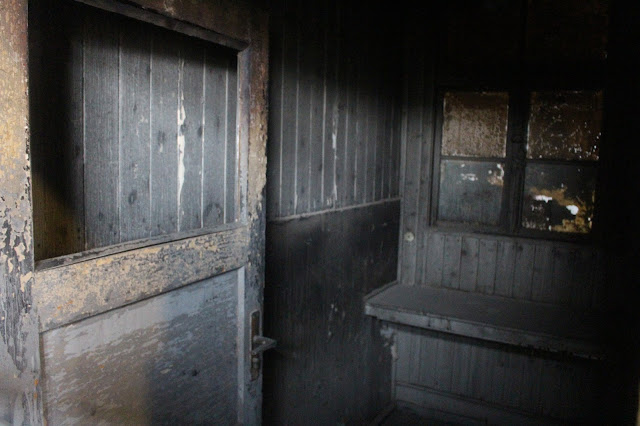I
realised I couldn’t do a weekend in Berlin and learn about all of this history
without going to a concentration camp. I initially thought about going on my
own and just getting an audio guide, but I knew I wanted to ask questions so I
booked a tour.
The
weather made the camp even more sombre the weather. It rained the entire time
we were there. Our guide said that the prisoners had to work even in these
conditions with thin clothes and colder weather which made me appreciate my
rain jacket even more. The gates welcomed visitors with the words “Arbeit Macht
Frei” which means work sets you free, a motto which most of the prisoners took
to heart and used as a motivation. If they worked hard enough they would be set
free, which was unfortunately rarely the case.
The
first area in the camp was the Appellplatz (Roll call square) where prisoners
had to be in the mornings to be counted, and because of the amount of people it
could take up to three hours. Around the camp was a line with black stones. If
a prisoner stepped onto them they would be killed on site. Some prisoners did
this on purpose as suicide and some really tried to escape, but unfortunately
the surrounded area was heavily guarded and on the other side of the camp was
where SS members were being trained. So chances of escaping and coming far was
almost nonexistent. The Jewish barracks were partly whole and partly a museum. It showed the living quarters, toilets and washing area. The museum part showed more detail of everyday life in the barracks.
The
next stop was the Gestapo prison which is located inside the camp. This is where
inspirational people were held, people who could cause an uprising and who
posed a threat to the way prisoners were thinking. Because the prisoners each
had a triangle with the colour of their conviction, they stayed with the
prisoners of the same colour, in that way everyone was divided. If one of these
inspirational prisoners were between the other prisoners they might have gotten
the prisoners to unite.
Our
next location was where the mass murders took place. The first was a shooting
range where prisoners got shot, but the SS soon realised that the trained
guards couldn’t handle shooting people up close because they became sympathetic
and was wasting too much bullets. The next place was where they made prisoners
go to make them think they had a check up; while their height was measured two
guards on the other side of the wall would shoot a bullet, killing the prisoner
instantly and without any fuss. The body would then be moved to the
crematorium.
Our
tour stopped after this, which caught me of guard because the pamphlet said we
would be visiting the Pathology department but we weren’t going to. So I left
the group to explore the building. There wasn’t much to it, but it was obvious
that it used to hold a lot of dead bodies in one place. The operating slabs
were undamaged and eerie, giving the building a ghostly feel.
Visiting
a concentration camp is quite depressing – I know – but worth it. It gives one
a better idea of what the prisoners went though on a daily basis. Seeing this
place first hand is a way of realising what humans are capable of. That harming
another person in any way is wrong, no matter what the reason.
I didn’t let myself be fully transported though time and think about where I was and what had happened where I was walking. Now, while writing this I feel full of motion and sorrow. There were a few moments when I wanted to cry, but I kept my tears in check. It was a beautifully painful experience and I don’t regret it.
Felicia
xoxo


































No comments:
Post a Comment